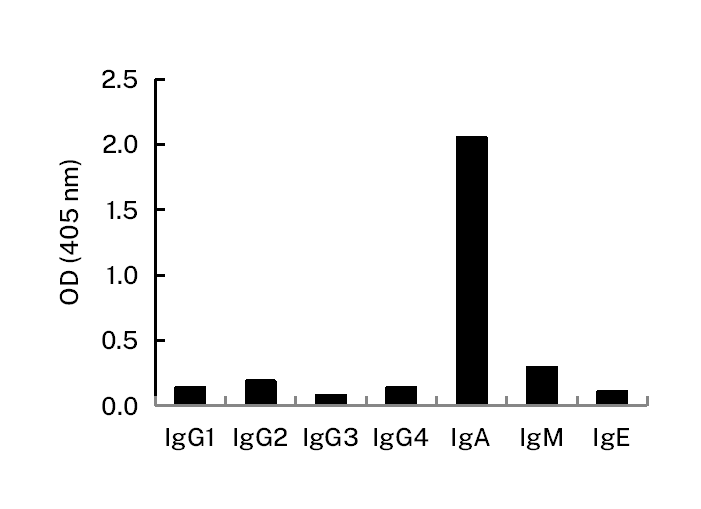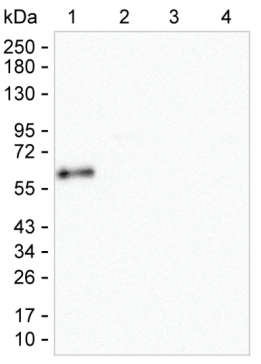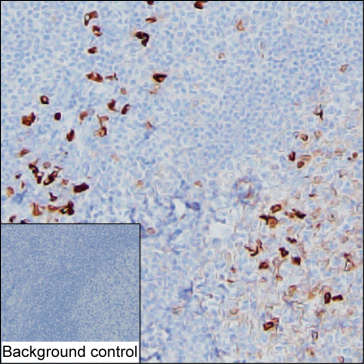


| WB | 咨询技术 | Human,Mouse,Rat |
| IF | 咨询技术 | Human,Mouse,Rat |
| IHC | 1/500-1/1000 | Human,Mouse,Rat |
| ICC | 技术咨询 | Human,Mouse,Rat |
| FCM | 咨询技术 | Human,Mouse,Rat |
| Elisa | 咨询技术 | Human,Mouse,Rat |
| Host/Isotype | Mouse IgG1 |
| Antibody Type | Primary antibody |
| Storage | Store at 4°C short term. Aliquot and store at -20°C long term. Avoid freeze/thaw cycles. |
| Species Reactivity | Human |
| Immunogen | Recombinant human IgA2 |
| Formulation | Purified antibody in PBS with 0.05% sodium azide |
+ +
以下是3篇关于人类IgA抗体的代表性文献(简要整理):
---
1. **文献名称**:*Mucosal immunoglobulins and their contributions to barrier defense*
**作者**:Woof, J. M., & Russell, M. W.
**摘要**:该综述系统总结了IgA(特别是分泌型IgA, sIgA)在黏膜免疫中的核心作用,包括其结构特征(如IgA1和IgA2亚型差异)、与黏膜上皮细胞多聚免疫球蛋白受体(pIgR)的相互作用,以及通过中和病原体和调节肠道菌群维持黏膜屏障的功能。
2. **文献名称**:*IgA-mediated mucosal immunity and the co-evolution of gut microbiota in mammals*
**作者**:Macpherson, A. J., et al.
**摘要**:研究探讨了肠道IgA如何通过靶向特定共生菌群,维持宿主-微生物共生平衡,提出IgA的“选择性包裹”机制可抑制致病菌定植,同时促进有益菌的肠道稳态。
3. **文献名称**:*Aberrant glycosylation of IgA1 as a genetic risk factor for IgA nephropathy*
**作者**:Novak, J., et al.
**摘要**:该文献揭示了IgA1分子糖基化异常(如半乳糖缺失)与IgA肾病(IgAN)的关联,提出自身抗体识别异常糖基化IgA1导致免疫复合物沉积,进而引发肾小球炎症的病理机制。
---
**备注**:如需具体文章年份或期刊,建议通过PubMed或Google Scholar检索作者名及关键词(如"IgA structure"或"IgA nephropathy")获取完整信息。
Human immunoglobulin A (IgA) is a critical antibody class in mucosal immunity, constituting 10-15% of total immunoglobulins in circulation. It exists in two primary forms: monomeric IgA1 (80-90% of serum IgA) and polymeric IgA2. which dominates mucosal secretions. A unique feature is secretory IgA (sIgA), formed when polymeric IgA binds the polymeric immunoglobulin receptor (pIgR) on epithelial cells, enabling transcytosis into mucosal surfaces like the gut, respiratory tract, and breast milk. This process adds a secretory component that protects sIgA from enzymatic degradation.
As the first-line defense at mucosal barriers, IgA neutralizes pathogens, blocks microbial adhesion, and facilitates antigen removal via "immune exclusion" without triggering inflammation. It maintains gut homeostasis by shaping microbiota composition through glycan-mediated interactions. While serum IgA1 mainly originates from bone marrow, mucosal IgA2 is predominantly produced by plasma cells in lamina propria under gut-associated lymphoid tissue (GALT) regulation.
IgA deficiencies (partial or total) affect 1:600 people, often asymptomatic but linked to increased respiratory/gut infections. Conversely, aberrant IgA responses contribute to pathologies like IgA nephropathy (IgAN), where galactose-deficient IgA1 forms immune complexes damaging kidney glomeruli. Its short serum half-life (5-6 days) contrasts with prolonged mucosal persistence, highlighting dual roles in systemic and local immunity. Current research explores IgA's therapeutic potential in microbiome modulation and mucosal vaccine design.
×